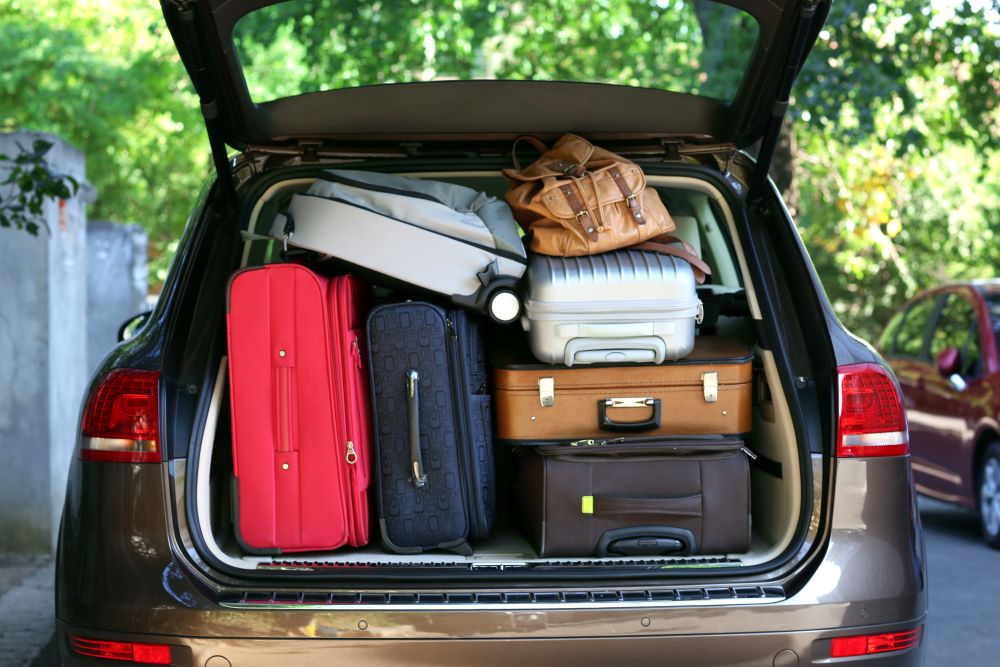Could you be fined for overpacking?

As we approach the summer holidays, many of us will be heading abroad or planning a staycation, to enjoy a well-deserved break. However, if you’re planning to travel with a lot of luggage, you need to take care to not overload your vehicle. Doing so could mean you unintentionally break the Highway Code, and be in “improper control of their vehicle”.
With this in mind, we at Howden are sharing our top tips on how to pack your car safely this summer and what you should do to ensure that your vehicle remains road safe despite the additional weight.
What are the rules around overloading a vehicle?
Rule 98 of the Highway Code states that you ‘must not overload your vehicle or trailer.’ This is supported by several of UK laws, including Section 100 of The Road Vehicles (Construction and Use) Regulations 1986, which says that the ‘weight, distribution, packing and adjustment of the load’ should not endanger anyone in the vehicle, or other road users.
So what does that mean for when you’re packing up, ready to hit the road?
Calculating your vehicle’s payload weight
The payload weight refers to the maximum amount of additional weight that you can add to your car before it is deemed unsafe. This includes the weight of the driver, any passengers, and luggage that will be loaded into the vehicle. You can use the following formula to calculate your vehicles payload weight.
Gross vehicle weight rating (GVWR) – kerb weight = payload weight
The GVWR refers to the maximum weight of the car and its contents, while the kerb weight refers to the weight of the car if it was empty and carrying a full tank of fuel.
The main figure to focus on is the payload weight. This should be available in your vehicle driver manual and indicates how much additional weight you can add to your vehicle.
The maximum payload weight will, understandably, vary depending on the size of your car. For smaller cars, such as the Kia Picanto, Fiat 500, and Volkswagen Polo, the maximum payload weight can be between 385kg and 482kg. Assuming you have four adult passengers, each with one suitcase and a piece of hand luggage, it becomes quite easy to exceed a 400kg payload.
Load Individual weight Combined weight 4x passengers 75kg 300kg 4x suitcases 20kg 80kg 4x pieces of hand luggage 10kg 40kg Total 105kg 420kg
Top tips for travelling with additional passengers and bags
Here are some of our top tips for maximising the amount of luggage you can safely travel with when heading on holiday.
Calculate the combined weight of passengers and luggage
If you are concerned that you’re going to exceed your vehicle’s maximum payload, it makes sense to weigh your luggage and your passengers before the journey. If you know the combined weight of everything you are packing into the car, you can be confident that you aren’t at risk of overloading.
Load the heaviest items in first
Start by loading the heaviest items of luggage into the bottom of the boot first. This helps the vehicle to maintain a lower centre of gravity and should make the vehicle easier to handle.
You can tuck smaller items of hand luggage under the rear passenger footwells. This will prevent the boot from being loaded above the top of the back seat, which may block your rear view as a driver.
Keep luggage strapped down
If you’re worried about luggage moving around during the journey, consider investing in a non-slip mat for the boot or bungee cords to keep it in place.
If you have an unused backseat, you can also use it to hold luggage. Use the seatbelts to help secure it in place and prevent it from moving around in transit.
Consider using vacuum sealed bags
If you are travelling with a lot of clothes, consider using vacuum sealed bags. While this won’t impact the overall weight of the luggage, it can reduce the overall size of the item by up to 75%, which can allow you to pack more into the boot without impacting the driver’s field of view.
Inflate your tyres to a higher pressure
To accommodate for the additional weight of more passengers and luggage, it is recommended to inflate your tyres beyond their usual pressure. Your vehicle handbook will indicate what PSI to inflate your tyres to, to ensure that your vehicle can still be driven safely with the added weight. Tyre pressure information is also sometimes displayed on the inside of your fuel door.
Ensure that you are inflating your tyres to the recommended PSI before beginning your journey while they are cold for the most accurate reading. If not, underinflated tyres can affect braking distance, steering, and fuel usage.
A member of our Travel Insurance team said:
“With nearly three-quarters of Brits intending to go on a holiday within the UK this year, many will be planning to drive to the airport at the start of their trip.
“It is easy to overpack when planning a holiday, especially if you have children. Rules around overpacking your car are often overlooked, but exceeding your vehicle’s payload can drastically increase stopping distance and reduce the control you have over the vehicle.”
And remember, if you have any questions about your car, van, or leisure insurance, our friendly, expert advisors are here to help. Simply find your nearest branch, and pop in to speak with one of the team or give us a call.
Sources: Vehicle payload calculation, travel trends







